A tale of two colonies….
You would be hard pushed to find a Dickens novel which would rival the antics of an active tern colony for stories of joy, woe, theft, violence, neglect and even murder.
In Montrose we are very lucky that we have two tern colonies, one with Arctic terns within the confines of the large Glaxo-Smith Kline (GSK) factory at the mouth of the River South Esk and a common tern colony which nest one the man-made raft installed by the Scottish Wildlife Trust in the middle of the Montrose Basin.
Each year trained ringers, who are registered with and are granted licences by the British Trust for Ornithology (BTO) monitor the productivity of both colonies by ringing the chicks. The process of ringing involves placing a uniquely numbered metal ring on the right leg of each chick, which will aid the BTO in monitoring population size, life spans, bird movements and breeding success.
This year the colony of Arctic terns at GSK appeared to be doing well, however, when local ringers visited the site just over a week ago (8 July), they were saddened to discover that there were only 4, yes four, chicks to ring. A possible explanation for the failure of the colony is the extremely heavy rain which the Montrose area experienced on 5-6 July. It has been suggested that the rain my have led the adult birds to desert the colony for long enough either for the larger gulls which nest nearby to predate the small chicks and eggs, or for chicks to chill and die and eggs to become cold and unviable.
All our hopes this year therefore fell on the scapulars of the common terns nesting on the “Maid of Sterna Stuff” on the Scottish Wildlife Trust reserve.

Last year when we visited the colony at the end of June most of the eggs had hatched and we ringed 110 chicks, estimating that there were roughly 10 chicks missed and further 10 chicks which were too small to ring.
This year the colony is about two weeks late, most likely due to the storm which swept the country on 23 May, so we didn’t make our annual ringing trip until last weekend (10 July).
Viewing from the Visitor Centre before heading out we approximated that there were 75-80 pairs on the raft, which is up on the c.60 pairs which were successful in 2010 and once the tides and weather were just right, we set off across the mud.
Upon approaching the raft, all the adult terns lifted and flew round in a tight flock, continuously calling loudly and dive bombing the intruders, typical defensive tern behaviour.
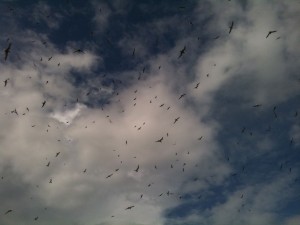
As we waded out to the raft, which was waist deep in parts, it was time to discover who had worn the old pairs of waders with tiny holes in them. Thankfully I wasn’t one of them!
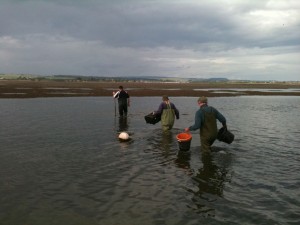
Armed with buckets for smaller chicks and holding cages for larger ones we carefully made our way round the raft gathering up as many chicks as we could. We collect the chicks in this way to prevent bigger birds trampling their smaller relatives.
As a few of us made a start on ringing the chicks, Scott and Marianne tallied up the number of eggs which were in scrapes and could still potentially hatch, counting 85 eggs.
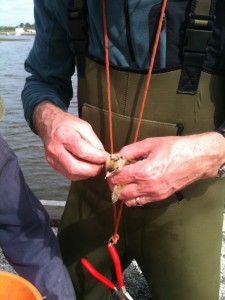
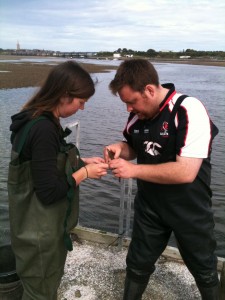
We keep the amount of time we spend on the raft to a minimum and just 30 minutes after first climbing onto the raft we ringed the final couple of chicks, packed up and started to make our way off again.
Thankfully the weather was sunny and warm with a slight breeze which was ideal for ringing the colony, but made walking across the mud in chest high rubber waders extremely hot and sweaty work.
Adding up the figures as we enjoyed a cup of tea we found 129 chicks had been ringed, with around 15 too small and only a couple missed. Although the birds are a couple of weeks behind last year they appear to have had to a good season and even if 50 of the remaining 85 eggs hatch, there is potential for almost 200 chicks fledging from the raft this year.

Before leaving the Centre we investigated one of the swallow nests which had been built under the eaves to see if there were any young and discovered 5 chicks suitable for ringing. So climbing up I carefully removed the tiny birds from their nest and once Ben and Marianne had ringed them, I delicately set them back into their mud-lined home.
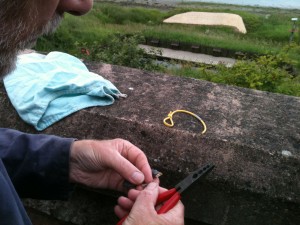
All of the data collected from the ringing of the terns and swallows will be submitted to the BTO who collate and coordinate all ringing within the British Isles and as mentioned above will be used to monitor movements, population sizes, productivity and survival.
You can report a ringed bird or find out more about ringing by visiting the BTO website.
Help protect Scotland’s wildlife
Our work to save Scotland’s wildlife is made possible thanks to the generosity of our members and supporters.
Join today from just £3 a month to help protect the species you love.
Preface
You would be hard pushed to find a Dickens novel which would rival the antics of an active tern colony for stories of joy, woe, theft, violence, neglect and even murder. …
